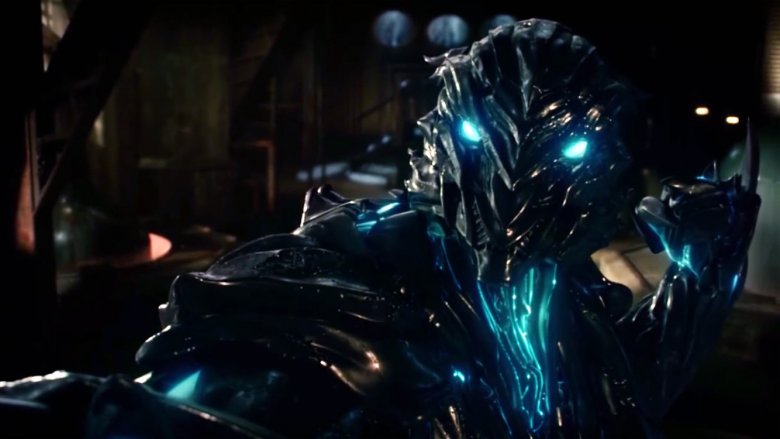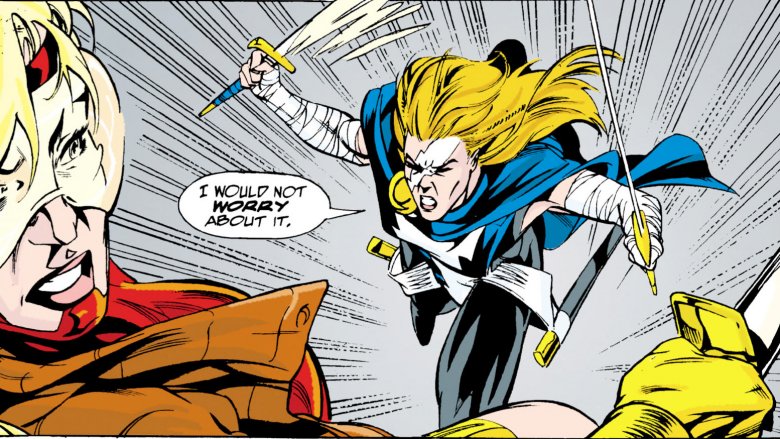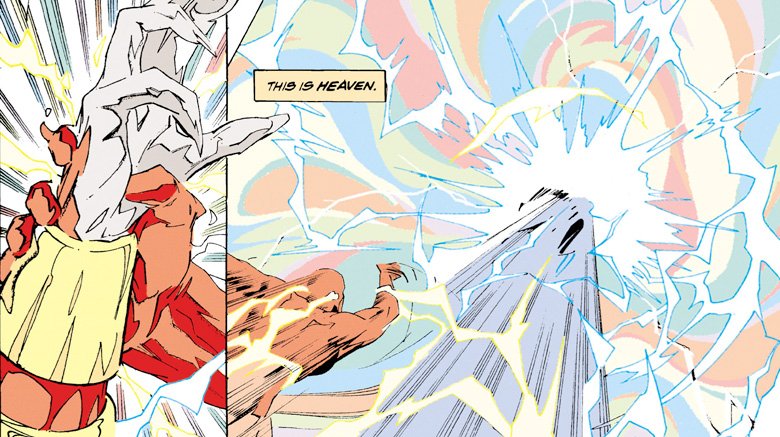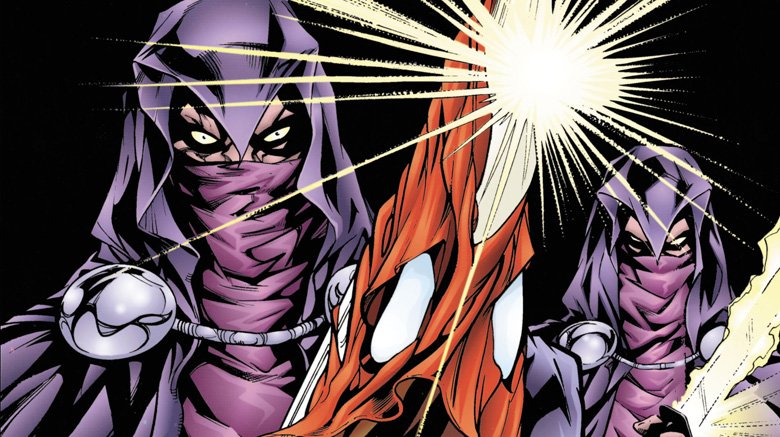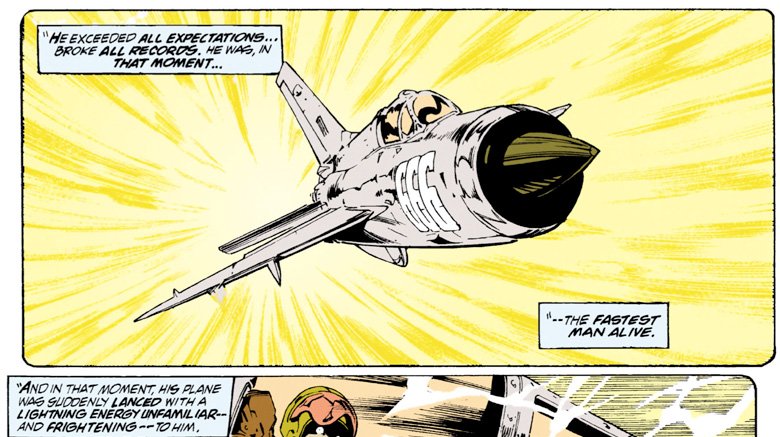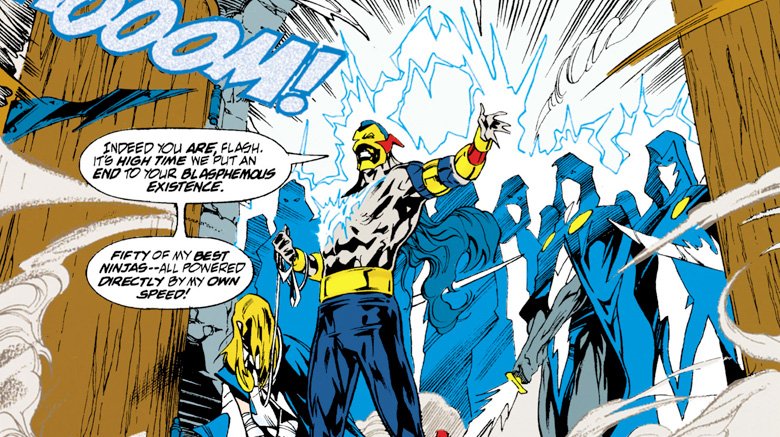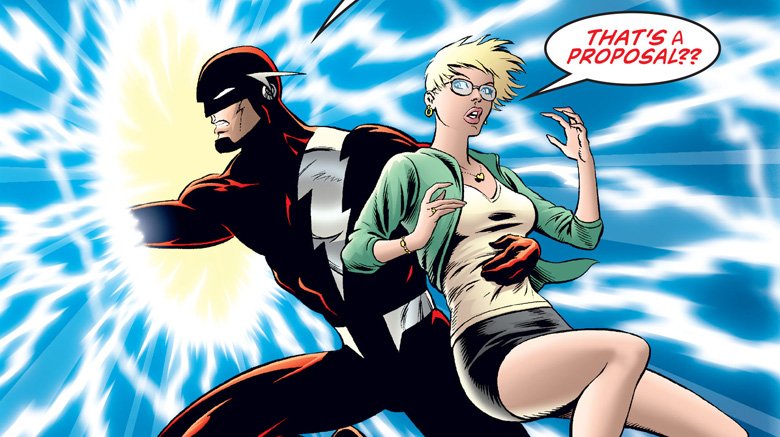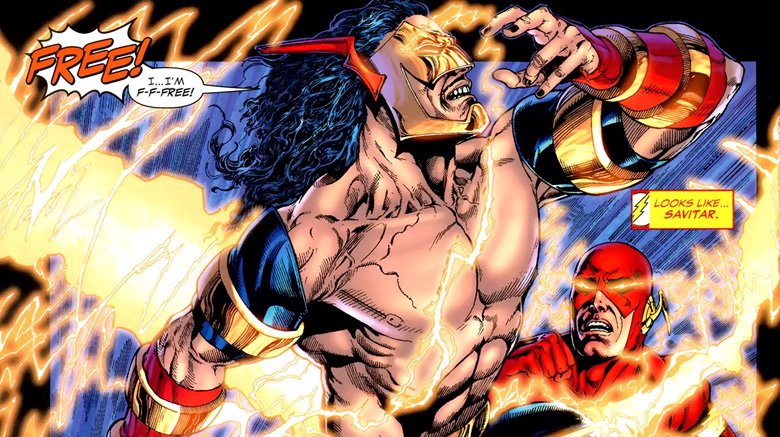The Untold Truth Of Savitar
The Flash is one of DC's best-loved classic heroes, with decades of adventures racked up over the decades — and he's has faced countless foes over the course of his long history, from sinister threats like the murderous Eboard Thawne and the powerful Weather Wizard all the way down to... well, to slightly less intimidating villains like Captain Boomerang and the Turtle, the Slowest Man Alive. Few of those arch-criminals, however, have ever been as horrifyingly threatening as Savitar.
With a mastery of speed that made him even faster than the Flash, Savitar has proven himself a worthy foe on numerous occasions. After all, as any hardcore DC Comics fan can tell you, we're talking about the guy who traveled through time, killed one of the DC Universe's most long-tenured speedsters, and even appeared on TV's Flash. But if that appearance left you with questions, here's the untold truth behind the character.
Vedic inspiration
In the same way that Thor wasn't an entirely new character created by Stan Lee and Jack Kirby in 1962 when they decided their new Marvel Universe needed 1,000 percent more hammering, "Savitar" wasn't a name that Mark Waid and Oscar Jiminez conjured up out of thin air — even if it does sound like the sort of name you'd give to someone who wanted to be the avatar of speed.
Instead, they drew their inspiration from Hinduism in the form of Savitr, a figure usually associated with the sun. In addition to being frequently described as beautiful, Savitr is responsible for keeping worshippers free from evil dreams, and is known to ride around the skies in a golden chariot that can assume any form, pulled by a pair of "radiant steeds." For the purposes of inspiring a supervillain, however, Savitr's primary attribute is that he's the lord of motion, responsible for everything that moves or stands still.
It's worth noting, though, that while other divine characters in comics — like Marvel's Thor, or DC's Ares — Savitar the supervillain is not actually meant to be a representation of his godly counterpart. Instead, even if he might see himself as the Lord of Speed, he's very explicitly shown to be a human being using the name. That's a crucial distinction when you're setting someone up to be beaten up by the fourth most popular member of the Justice League.
Speed Kills
While he's arguably the most dangerous, Savitar isn't the only evil speedster who's (quite literally) running around the DC Universe. In fact there are so many of them, both heroes and villains, that we've all just sort of gotten used to hearing the word "speedster," which is objectively pretty weird. Maybe not as weird as those Sonic the Hedgehog comics that refer to their main character as a "quickster," but still.
The most famous villain on the bad side of things is, of course, Professor Zoom, the Reverse Flash, who easily takes the prize for having the most ridiculously supervillainous name of all time. Further down the ladder are the Soviet speedsters of Red Trinity, who gave up on state-sponsored supervillainy once the USSR collapsed and became a super-fast messenger service named Kapitalist Kouriers.
The most notable of the minor speedsters, though, is undoubtedly Christina Alexandrova. Originally a member of another Soviet trio called Blue Trinity, she was unfortunately lacking in her own personality. As a result, she fell in with different groups, first Blue Trinity, and then alongside immortal caveman Vandal Savage, who sent her after the Flash in the identity of Lady Savage. Unfortunately for Vandal — and for Wally West, it turned out — she became obsessed with him instead, and styled herself as Lady Flash. Wally rebuffed her affections, and that was that... until she fell under the sway of a certain speed-obsessed cult leader who thought of himself as a god, that is.
The Speed Force
The classic origin story for the Flash involves Barry Allen being struck by electrified chemicals and gaining the power of super-speed — and then accidentally repeating the exact same origin story when he was showing his protégé, Wally West, how he got his powers. Even by the standards of a genre that frequently fills its superheroic origin stories with stuff like radioactive spiders, toxic chemical spills, and just being really angry basically all the time, that's pretty dubious.
Or at least, that was the idea that longtime Flash writer Mark Waid had when he came up with an idea that would retcon not just the Flash's origin, but unite every super-speed character in the entire universe: the Speed Force. The quick version (get it?) is that it's essentially the extradimensional source of the very concept of speed. With some kind of intelligence guiding it — which, spoiler warning, was later revealed to be Wally himself moving backwards through time — it occasionally chooses people to imbue with speed powers. Oh, and it also serves as heaven for speedsters who run themselves to death.
Surprisingly, this actually makes more sense than "electrified chemicals make you run good," at least in the context of a universe where a couple dozen people can break the sound barrier in a pair of Jordans. But it also gave a few of those speedsters a tangible connection to this massive, unknowable source of all their power, and inspired a few, like Savitar, to devote their lives to understanding its seemingly divine secrets... at all costs.
Savitar's ninja death cult
Like all self-respecting gods, Savitar wanted worshippers — and like all self-respecting comic book villains from the '90s, he also wanted a seemingly endless supply of ninja henchmen that could do his bidding at super-speed. With his powers and his religious devotion to tapping into the source of all speed, he was able to gather plenty of followers to serve as both, and that's what set him aside from other villains.
Rather than just employing henchmen as backups, Savitar's powers allowed him to imbue them with his own super-speed, making each of them as fast as the Flash, and allowing for a terrible punishment when they failed in their duties. With his control over speed, he could cause them to age so rapidly that they'd turn to dust in seconds, leaving only their swords and scary ninja suits behind.
Oh, right: they were also ninjas. That part of the story is a little more glossed over — and sadly didn't make it into the live-action version that appeared on the CW's Flash TV show — but we're told that the cult he founded flourished while he was bouncing through time after ricocheting off the Speed Force. Presumably, all those years waiting for the resurrection of their lord and master gave them plenty of time to practice using smoke bombs and katanas.
The secret origin of Savitar
While he's rightly considered to be one of the major villains of Wally West's tenure as the Flash, his true arch-nemesis is one of DC's much less well-known speedsters: Max Mercury. Like Savitar, Max was obsessed with the Speed Force, but in a much less murderous way. Instead, he devoted himself to becoming the "Zen master of speed," studying the speed force and communing with it while also battling against evil. Every now and then, though, he would be unable to resist trying to break through to it, and wound up bouncing through time to fight crime in different eras.
That's what brought him into an encounter with Savitar. As revealed to Wally through one of Max's journals, Savitar — whose civilian identity is only ever given as "a Cold War patriot, a military pilot from a third-world nation" — flew an experimental aircraft so fast that he brushed up against the Speed Force and gave him super-powers and an incredible understanding of what those powers could do, including rapidly healing any wound within seconds. Thus: the ninja cult.
Seeing the other speedsters as thieves who were stealing the power that was rightfully his, Savitar started hunting down Golden Age heroes like Johnny Quick, until Max intervened and sent him bouncing off the edge of the Speed Force and through the timestream. The problem with that, though, is that it's really just delaying the problem until it comes back and, you know, starts murdering people.
Dead Heat
Savitar made his comics debut in 1995's Flash #108 to kick off a six-part storyline called "Dead Heat." In it, he made his return from the Speed Force, gathered up all his ninjas, and quickly set about taking out every other rival to his position as the universe's only speedster. The interesting thing was, he didn't just send the ninjas after them. He started by taking away their speed.
In the same way that he could lend his henchmen his own power in order to make them super-speed assassins, his ability to control motion also gave him the ability to absorb the powers of other characters. The only problem was that he had to put all that speed somewhere and couldn't contain it himself, but he solved that one by building a giant alchemical battery hooked up to — what else? — a bunch of ninjas. The only person whose powers he couldn't take was the one with a direct connection to the Speed Force itself: Wally West, the Flash.
Unfortunately, that left one of the members of Kapitalist Kouriers powerless as he was running up the side of a skyscraper, and that was just the beginning. He taunted the Flash by carving a map to his headquarters into Max Mercury's chest, and in the resulting battle, he finally killed Johnny Quick. Fortunately, the Flash was able to defeat him by giving him exactly what he wanted: dragging him directly into the Speed Force itself and letting its residents be his jailers.
Walter West: The Fastest Man Alive?
Savitar's legacy didn't quite end with the end of Dead Heat, though. In 1999, after Wally West was apparently killed fighting a villain named Cobalt Blue, a new, darker Flash made his appearance in Central City. The mystery of who this new Flash could be ran for months, and was especially intriguing since he revealed himself to other characters — but not the reader — only to have him reveal that he was someone they'd trust implicitly. Finally, fans got the shocking revelation when it turned out that the all-new, all-different Flash was... Wally West. Sort of.
See, while our own Wallace West had been Flash since he took over from Barry Allen in 1987, this was Walter West — a version of Wally from another dimension who took a much more hard-line approach to the criminals of his world. After losing his fiancée in a battle against a villain called Kobra, Walter started taking out criminals, permanently. He even murdered Savitar, but not before he fooled him into thinking that he wanted to be one of his disciples. With that, Walter was able to learn all of Savitar's secret techniques for controlling speed — stuff that Wallace never figured out on his own.
Until the two Wallies West wound up briefly merging into one, giving the regular Flash — who hadn't actually died — the knowledge of his counterpart's speed tricks, and helping Walter regain his senses long enough to realize that he could do more good by taking over for his presumed-dead counterpart in the regular DC Universe until the genuine article came back. We'd say "it's not as complicated as it sounds," but, well, in this case, it actually is.
R.I.P. Savitar, 1995 - 2009
Savitar's final comics appearance (so far) came after a 13-year absence following his initial defeat at the end of "Dead Heat." That might seem like a pretty big gap for a character that made the scene as a major villain, but hey: at least he didn't last two pages before crumbling into a pile of dust and bones just because he was barely touched by a superhero, right?
Wait, no. Sorry, we had our notes mixed up. That's exactly what happens.
Yes, after 13 years, the self-described God of Speed finally managed to extricate himself from the Speed Force, only to die almost immediately in a way that's pretty incontrovertible, even for a genre that eventually brings pretty much everyone back from the dead one way or another. Then again, Barry Allen himself once dissolved into dust, and that didn't stop him from returning with a mysterious death touch that was solved in about four issues.
TV's Savitar
Savitar was featured as the major villain in the third season of the CW's Flash TV show, but while he shared a name with his comics counterpart, that was about all that the two characters had in common. While TV's version of Savitar was certainly able to recruit lesser villains to do his dirty work, he hardly qualifies as a "cult leader," and sadly, none of those lesser villains were ninjas. Honestly, at that point, why even bother?
Instead, the driving plot line for TV's Savitar was centered around the question of his secret identity. He had the same super-speed powers as the Flash, but was able to use them more effectively — just like the Savitar of the comics — but his hatred for Barry Allen was far more personal than just wanting to destroy a rival speedster. At the end of the day — and here's your spoiler warning if you're still catching up via Netflix — Savitar turned out to be... Barry Allen.
Sadly, the showrunners didn't take all the cues from the Dark Flash saga and give us Balter and Ballace Allen duking it out to determine the one true Flash. While their version of Savitar did have the same kind of scarred face that readers had seen with Walter West, he was revealed to be a version of Barry from a future where he was even more of a mopey grump than usual, and where tragedy had driven to him running around in armor that made him look like a super-speed version of Stryfe from X-Force.
